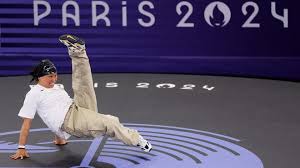During the Paris Olympics, a new event called Breaking was debuted. Breaking is scored in 5 categories: Technique, Vocabulary, Execution, Musicality, and Originality. Each category represents 20% of the total score. In all of the breaking battles, the athlete designated as “Blue” gets to decide if they want to go first or let their opponent, designated as “Red” go first. Breaking was debuted at this years’ olympics but is not being brought back to the 2028 games.
Breakdancing was invented in the streets of New York in 1970. It has evolved into a proper dance sport with a fixed set of rules that make for fair competition. Breaking was debuted in the 2018 Youth Olympics in Buenos Aires, Argentina, and made its official Olympic debut in the 2024 Olympics in Paris, France. There are 3 rounds, and whoever wins the most rounds wins the battle. For the judges, if the majority votes for one of the athletes, that athlete wins the round. There are usually nine judges on a panel.
There are a couple of basic breaking moves: top rock, down rock, and freeze. A top rock move is any move when the athlete is standing up. It is generally a combination of stylish hand movements and footwork. A freeze move is when the breaker stands still in an unusual position (particularly on their hands or on their head) in the middle of their dance. Often, the highlight of the performance are the down rocks, which are all moves done on the floor. Some common down moves include: spins, footwork moves, transitions and the crucial power moves. Power moves are a set of movements the athletes show off by spinning their entire body on their hands, elbows, back, and head or shoulders! The acrobatic movements require elite strength, balance, and flexibility. An example of a power move would be an air flare. In an air flare, dancers rotate their body, while upside down, while switching their balance on either arm and moving in a circular motion.
In the Olympics this year, in the men’s breaking tournament, the gold medal went to a Canadian breaker named Phil Wizard, who defeated French breaker Dany Dann in the gold medal battle 3-0. The silver went to a French breaker named Dany Dann, who lost the gold medal battle 0-3. The bronze went to an American breaker named Victor Montalvo, who competes with the name B-Boy Victor. He defeated Japanese breaker Shigeyuki Shigekix 3-0 in the bronze medal battle. In the women’s breaking tournament, the gold medal went to a Japanese breaker named Ami Yuasa, with a score of 3-0 in the three rounds. The silver went to a Lithuanian breaker named Dominika Banevic, who lost the final 0-3 in the three rounds. The bronze went to a Chinese breaker named Liu Qingyi, who defeated India Sardjoe 2-1 in the bronze medal battle.
Breaking is not being brought back to the 2028 Olympic Games in Los Angeles, California. It’s being removed from the games and being replaced by flag football, cricket, lacrosse, and squash over breaking. Despite the games deep history, especially in the Bronx, New York, it is being removed from the games and might not ever be added back in. Breaking will still be done, but is removed from the Olympics for at least 2028.
Cites – :
https://www.espn.com
https://olympics.com
https://olympics.com
https://results.nbcolympics.com/breaking/womens-event/medal-round/645033001
https://www.nbcolympics.com
https://www.usatoday.com/story/sports/olympics/2024/08/10/breaking-future-summer-olympics/74751426007/#:~:text=But%20even%20from%20the%20start,which%20breaking%20will%20not%20be.








